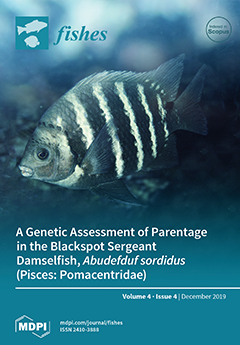The blue gourami (
Trichogaster trichopterus) is a model for hormonal control of reproduction in Anabantidae fish, but also relevant to other vertebrates. We analyzed the female blue gourami brain transcriptome in two developmental stages: pre-vitellogenesis (PVTL) before yolk accumulation in the oocytes, and high vitellogenesis (HVTL) at the end of yolk accumulation in the oocytes. RNA sequencing of whole-brain transcriptome identified 34,368 unique transcripts, 23,710 of which could be annotated by homology with other species. We focused on the transcripts showing significant differences between the stages. Seventeen and fourteen annotated genes were found to be upregulated in PVTL and HVTL, respectively. Five nuclear transcripts, three of which contain the homeobox domain (
ARX, DLX5, CERS6), were upregulated in PVTL. Additionally, several receptors previously known to be involved in reproduction were identified, and three of these, G-protein coupled receptor 54, Membrane progesterone receptor epsilon, and Gonadotropin-releasing hormone II receptor (
GPCR, mPR, and
GnRHR) were measured by quantitative RT-PCR in brain, pituitary, and ovary samples from PVTL and HVTL stage females. Of these,
GPCR was highly expressed in the brain and pituitary as compared to the ovary in both PVTL and HVTL.
GnRHR was highly expressed in the ovary compared to the brain and pituitary, and its levels in the brain were significantly higher in PVTL than HVTL. Brain
mPR mRNA levels were likewise higher in PVTL than HVTL. In conclusion, this study details changes in the female blue gourami brain transcriptome through yolk accumulation in the oocytes and identifies key genes that may mediate this process.
Full article





